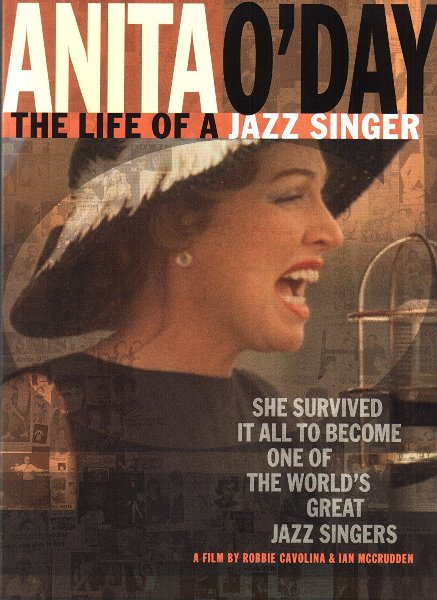

 |
Anita O'Day The Life of a Jazz Singer
 |
|
Anita
O’Day without question was one of the most talented female jazz vocalists to
ever live. Also without question, she was controversial and battled substance
abuse demons throughout most of her life. Directors Robbie Cavolina and Ian
McCrudden, who along with Melissa Davis produced the film
Anita O’Day
The Life of a Jazz Singer, talked candidly
with Riveting Riffs Magazine, about the singer’s life and the making of the
documentary, during two separate conversations. The film will have a limited
cinematic release on August 15th
in Cavolina, was the recipient
of a Grammy Award in 1996, for art direction on Joni Mitchell’s album
Turbulent
Indigo and also directed two short
Mitchell documentaries, Joni Mitchell
Hits and
Misses and
Shine.
He recalls his first meeting with Anita O’Day. “I first met her at the Vine
Street Bar and Grill in “I went back the next night (to see Anita O’Day), and
she was not drunk. She was seventy-three at the time, and I have never in my
life heard a young person, old person or middle age person sing the way that
this woman sang. Not only did she knock the house down, but she was
unbelievable, in the way that she sounded and with what she was doing on stage.
I took pictures that night and when I went back the next week to give them to
her, we struck up a friendship,” says Cavolina, relating his 1992 encounter with
the jazz legend. Ian McCrudden says, “I met
Anita when I went to see her at the Atlas Café. It was through Robbie, and at
that point, he wasn’t working with her. It was in ’96 or ’97. He said that I had
to check this lady out. I knew her music, a little bit, but I wasn’t an
aficionado (however) I was into jazz. When I went to see her for the third time,
they were showing old clips of her singing. I thought from that point on, that
it was an amazing story. I became interested, as someone who was primarily a
filmmaker.
I have made seven feature films. I thought
that it would be really interesting to try and make a documentary.” Cavolina and McCrudden
continued with their filmmaking careers, with McCrudden hooking up with Melissa
Davis to found Elan Entertainment. The duo produced the critically acclaimed
movie
Islander in 2007. Davis’ other film
credits include the 2008 production of
The Things We
Carry,
Trespassers
(2006), and Elan Entertainment is currently developing
Swedish
Midsummer Comedy, a co-production with
Casa Nova Films and
Cigar Diaries,
an action adventure film.
In addition to his work on
Islander
and
Trespassers,
McCrudden also directed
The Big Day
which starred Julianna Margulies,
Mr. Smith Gets a Hustler
and
Trailer—The Movie. McCrudden has also
directed several plays and written numerous screenplays. Cavolina reunited with Anita
O’Day, when, “In 1999 I found out that she was very ill, so I phoned her manager
to ask if I could go over to see her. He said sure come on over and he said by
the way the rights (to a film) are available. I sold everything that I had (to
obtain the rights). I had just started a little editing company, so I thought I
could make a film.
Anita and I became friends and I got close to
her. I started studying her and listening to all of her records. I found
everything that I could about her and watched all her video tapes so that I
could really understand her. Then I read the book (High
Times Hard Times) and I (initially)
thought that I was going to make it into a feature film, a biopic. Later, when
Ian came into the picture in 2003, he said that I should make the documentary,
because it would seed the picture. He told me to do the documentary first. I
asked Anita if she would want us to do that and she said ya”
As Cavolina became more involved with Anita O’Day and in
her later years acted as her manager, McCrudden and Davis’ interest in making a
documentary grew. McCrudden says, “Melissa raised some financing pretty quickly.
It all began with seeing Anita O’Day singing, and feeling that there was a story
there. It was a little rough shod, because in some of her shows she was drunk. I
was however, interested in this person who continued to do her art, as though it
was her whole life.” The two producer / directors could have spent more time
focusing on the more sordid details of Anita O’Day’s life but just as they were
not out to glam up who she was, neither were they intent on only exploring her
addictions and what at times could amount to destructive behavior. They set out
instead to create a balanced, but realistic movie which possesses some stunning
archival film footage of the singer’s performances, including one section of the
film where four separate clips of her singing, “Let’s Fall In Love,” are
presented in a montage. “We couldn’t decide which one (video clip of “Let’s Fall
In Love”) to put in, so I said to Ian let’s put them all in. She was giving Dr
Billy Taylor a lesson on improvisation, so I thought why not show it all,
because she is doing it four different ways.,” says Cavolina. For his part, Cavolina did
not want
Anita O’Day Life of a Jazz Singer
to reflect what he had watched in numerous other jazz documentaries. “I had seen
every single jazz documentary on the planet. I cried while watching Louis
Armstrong’s and Chet Baker’s was so, so sad. The stories of Billie Holiday and
Charlie Parker were also sad. I thought these guys weren’t sad. Not to diss
documentary filmmakers, because I think they want to tell a story, and yes if
you put their stories on paper, a lot of the things that these people went
through is sad, but they were brilliant people, who were able to do one of the
most difficult things, which is to improvise music, with instruments that most
people can’t even play.” Cavolina remembers, “I asked Anita one day, what jazz is
and she said, it is having the ability to improvise, make it up as you go, and
to be good at it. She lived her life one hundred percent for music. She was like
Vincent Van Gogh, who just painted, painted and painted. She said, ‘I got good,
because I just did it, did it and did it.” Both directors made sure that any comments that were
made about Anita O’Day’s use of heroin and alcohol abuse came from archival
footage of her interviews. “It was fairly well
documented in her own book that she struggled with substance abuse and had
multiple abortions. The book was a little bit of a tell all.
The decision as to how to handle it was taken
from what she would talk about herself. If you notice, in the movie, we do not
have anyone else speculating or gossiping about her use of drugs. You see what
she says about it, either to an interviewer like Tom Schneider, Dick Cavett or
Harry Reasoner.
The thing that I would say about Anita is she
didn’t glamorize it or think that it was cool. She is not proud, but on the
other hand, I don’t think that she is regretful. The trick was to try and show
it the way that she sees it,” says McCrudden. Anita O’Day’s highlight years belong to another
generation when she became the first female singer to record her first solo
project with Verve Records in 1954. More than thirty of her hit songs are
featured in this film, tunes such as, “Sweet Georgia Brown,” “Body and Soul,”
“Boogie Blues,” “Tabby the Cat,” “Angel Eyes,” and “Pennies From Heaven.” The
songs and performance clips revive fond memories for those who are old enough to
have enjoyed O’Day’s music during her heyday and they introduce a new generation
of jazz fans to her music for the first time.
“I feel that a lot of the jazz coming out now does not
have a real understanding of what the art is. I think that this is the way that
people can see the real deal. She was really doing something special, that a lot
of people were not doing. She had a life to what she did. She could do a ballad
like nobody else. She would just tell the story and make the music tell the
story and without a lot of opinions or the flavor of the day. If a song was slow
and she wanted to do it fast, but was told that she couldn’t do it, she would
say, ‘Do you want to make a bet?’ She was like an improvisational scientist. She
had such a good ear, and such a good sense for putting things in the right
places and for working with the right people who could do that,” says Cavolina.
Unless you are a history buff or enjoy biographies, chances are you do not watch
a lot of documentaries, because many of them tend to lack imagination and are to
be quite frank, often they plod along. Cavolina credits McCrudden’s creative
storytelling and his ability to think outside the box for largely contributing
to the entertainment value of
Anita O’Day The Life of a Jazz Singer. “We didn’t have a script. I would be in the editing room
with Robbie and figuring out how to make it into a real story, not just venting
the facts and having talking head interviews. We also poured over all the
musical footage, absorbed the lyrics, when the records were made and what was
going on in her life (at the time). We wanted to hook the audience into a
parallel story, which was being told through the performances. I studied those
performance clips, like you would in a narrative feature. I think that our
approach was unique. Certainly, her interviews reveal her somewhat too. I think
that approach is a little different than people who may just throw a song in
here or there, because they feel it is time add a song. Performance works in a
movie, because it is subliminal and it is not because of any particular line
that the performer had. It starts to build on you and you get a feel for the
person,” explains McCrudden. We have just barely scratched
the surface of this splendid film and if you live in
|